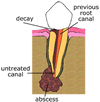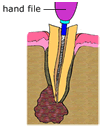|
|
| |
|
Root Canal Retreatment
|
| |
|
 Retreatment is necessary when bacteria have re-entered
the tooth. This is usually due to decay or untreated
canal areas. The patient may experience swelling or
pain in chewing. Retreatment is necessary when bacteria have re-entered
the tooth. This is usually due to decay or untreated
canal areas. The patient may experience swelling or
pain in chewing.
Sometimes a patient may have no symptoms, but an x-ray
shows that there is a problem with a tooth that has
previously undergone root canal therapy.
|
What Happens During Root Canal Retreatment?
 Step one: Step one:
After the tooth is "numbed", the canal system
will be reopened to remove the previous root canal material.
This may involve removing a crown, post and core material.
Sometimes we are able to make a small hole in the existing
restoration and work through that opening. The canals
are then thoroughly cleansed and shaped.
|
 Step two: Step two:
The canals are refilled with gutta-percha and the opening
is sealed with a sterile cotton pellet and a temporary
filling.
|
 Step three: Step three:
The tooth is usually restored within a couple of weeks.
If your existing crown can be saved, then you will need
to have it repaired. If you do not have a crown, it
will probably be recommended.
With time, the bone will heal where the bacteria was
removed.
|
|
|
|
|

|
© Copyright 2005- Dental WebSmith, Inc. and Matthew
J. Vertin, DDS, PC. All rights reserved worldwide. Disclaimer:
The information provided within is intended to help you better understand dental
conditions and procedures. It is not meant to serve as delivery of medical or
dental care. If you have specific questions or concerns, contact your health care
provider. |
|

 Retreatment is necessary when bacteria have re-entered
the tooth. This is usually due to decay or untreated
canal areas. The patient may experience swelling or
pain in chewing.
Retreatment is necessary when bacteria have re-entered
the tooth. This is usually due to decay or untreated
canal areas. The patient may experience swelling or
pain in chewing. Step one:
Step one: Step two:
Step two: Step three:
Step three: